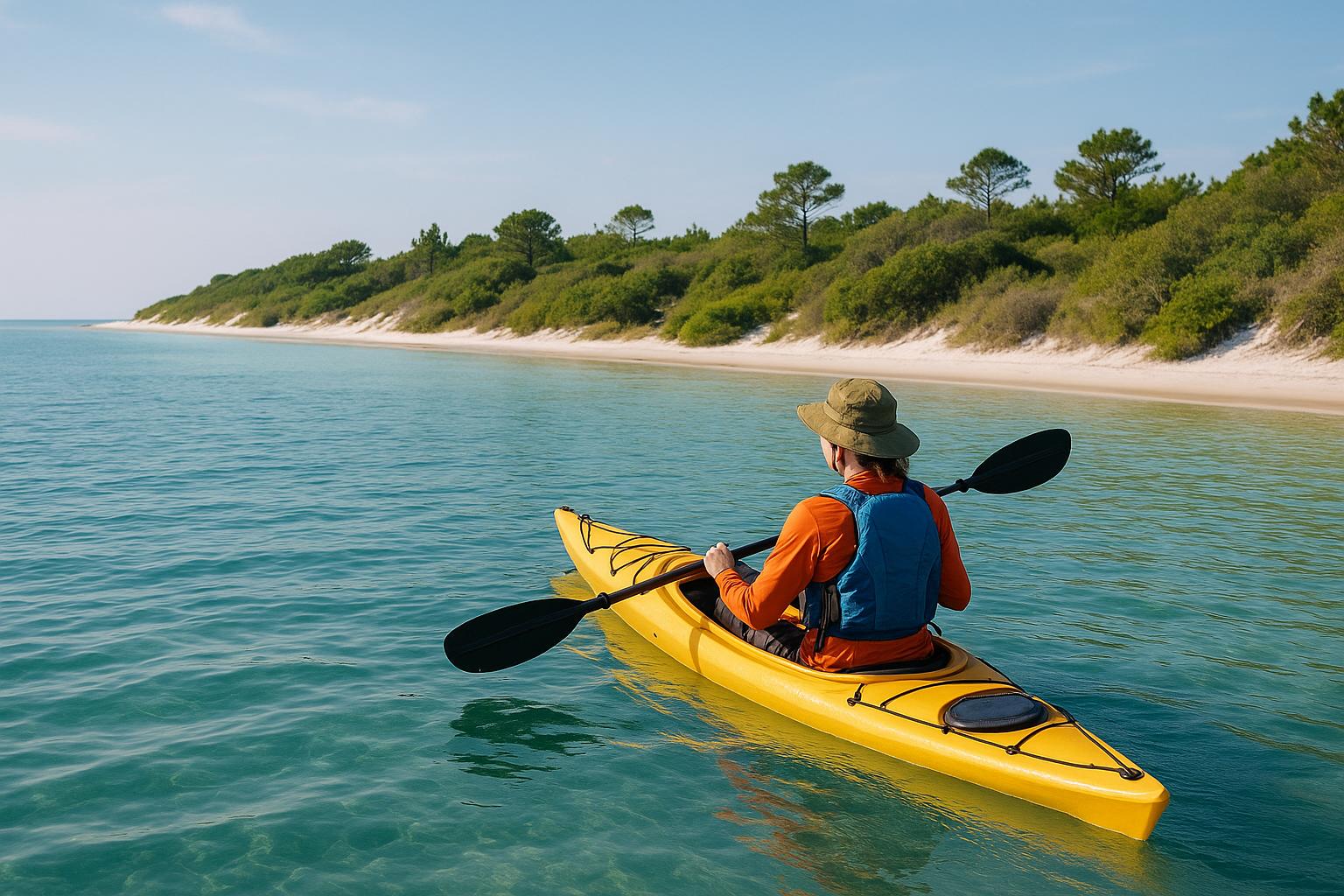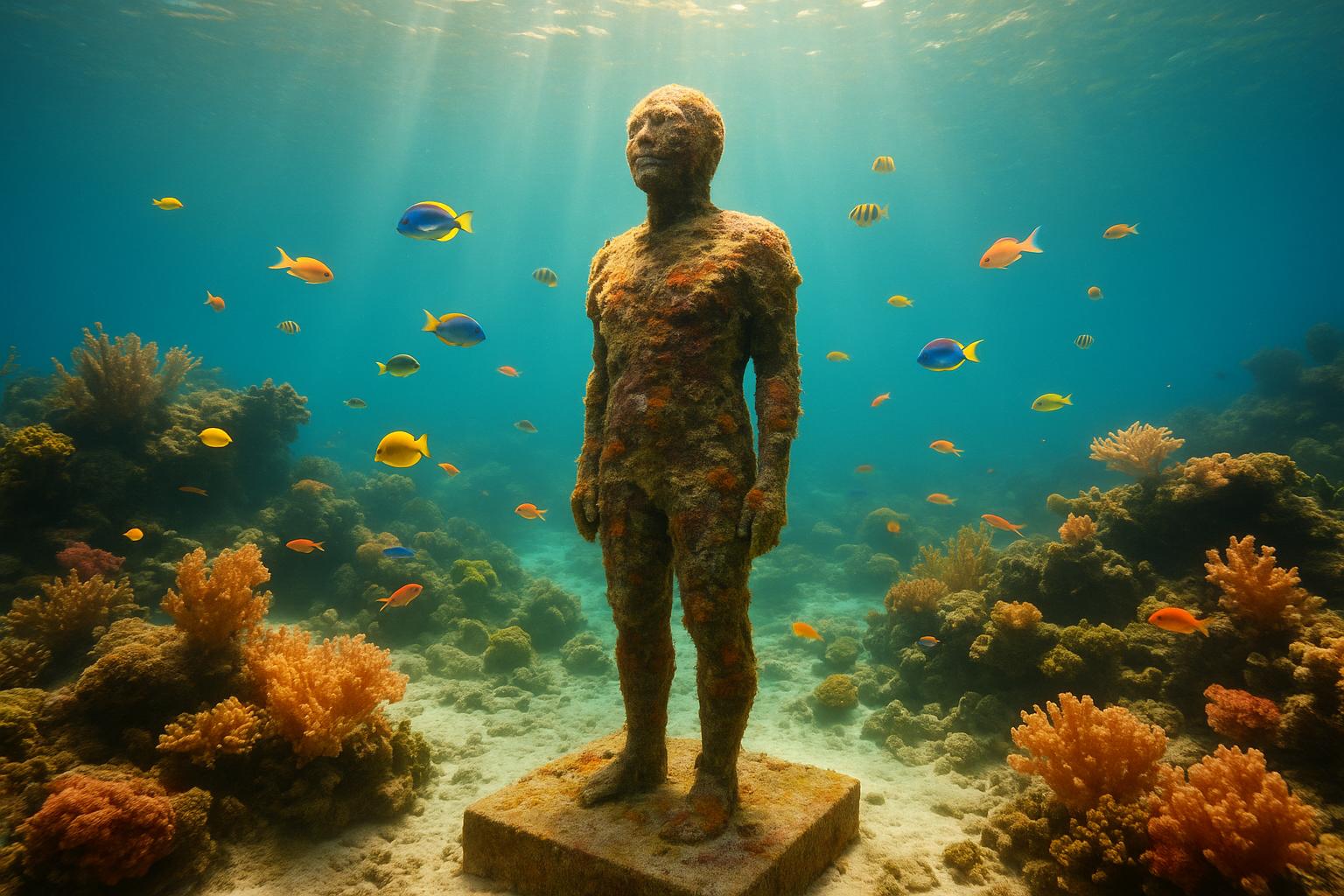South Walton is a birdwatcher’s dream, offering over 200 bird species across diverse habitats like coastal dune lakes, pine forests, and quiet beaches. Nestled along major migratory flyways, it’s a hotspot for both resident and migratory birds. Key locations include Topsail Hill Preserve, Deer Lake State Park, and Point Washington State Forest. Rare finds like the Semipalmated Plover and Osprey are highlights. Birdwatching is best early morning or late afternoon, and patience is key. Equip yourself with binoculars, a field guide, and neutral clothing for a successful outing. Stick to trails, respect wildlife, and enjoy the rich birdlife South Walton has to offer.
Best Birdwatching Spots in South Walton
South Walton is a haven for bird enthusiasts, thanks to its protected areas and diverse natural habitats. These unique ecosystems attract an array of bird species throughout the year. Here are four standout locations that highlight the region's rich birdwatching opportunities.
Topsail Hill Preserve State Park
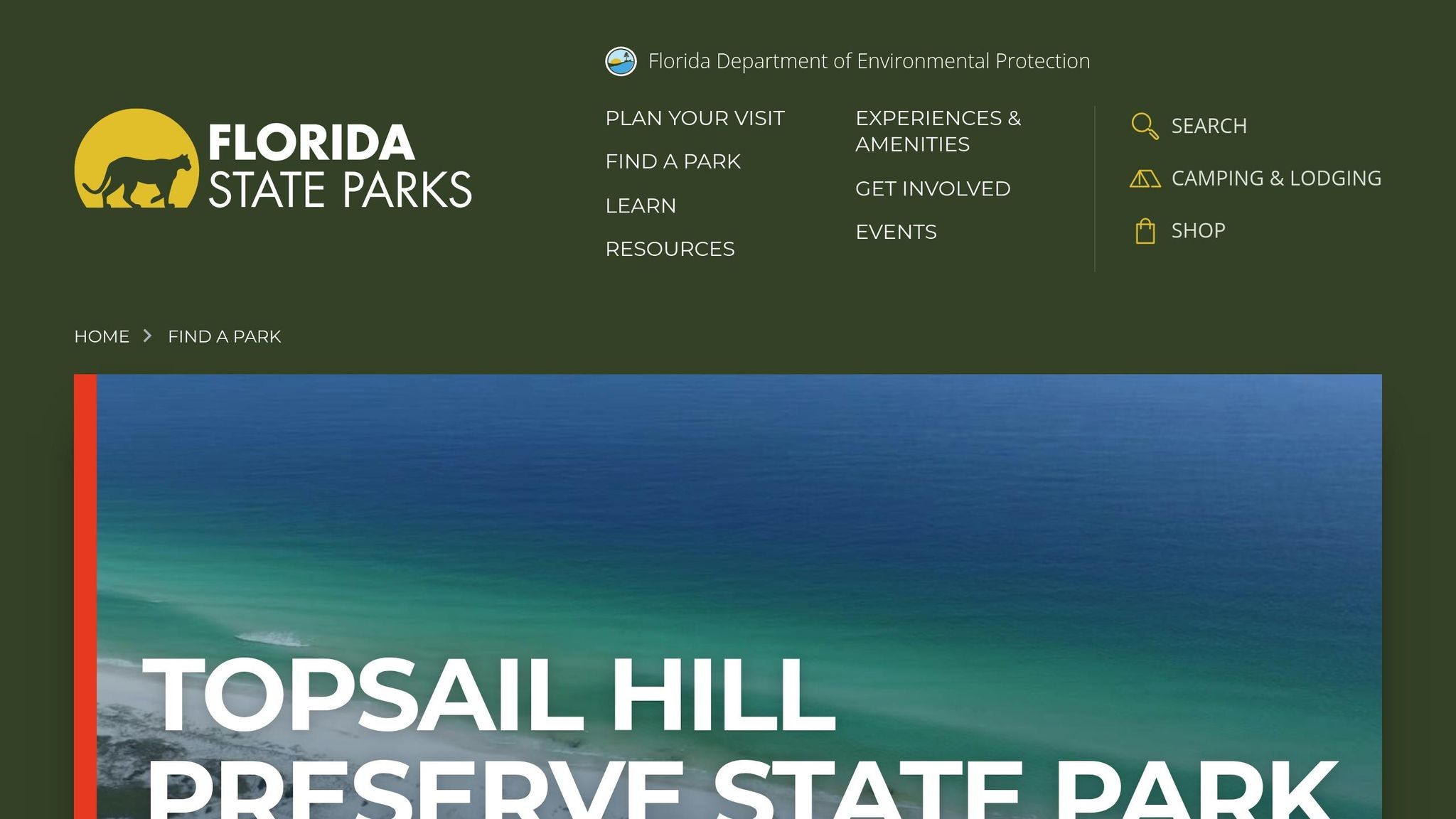
Topsail Hill Preserve State Park is a must-visit for birdwatchers. Its mix of coastal and inland habitats draws both resident and migratory birds. The pine flatwoods and scrub areas serve as nesting grounds for woodland species, while the park's wetlands are a year-round home for waterbirds. Arrive early to experience the park's varied ecosystems in their most tranquil state.
Deer Lake State Park
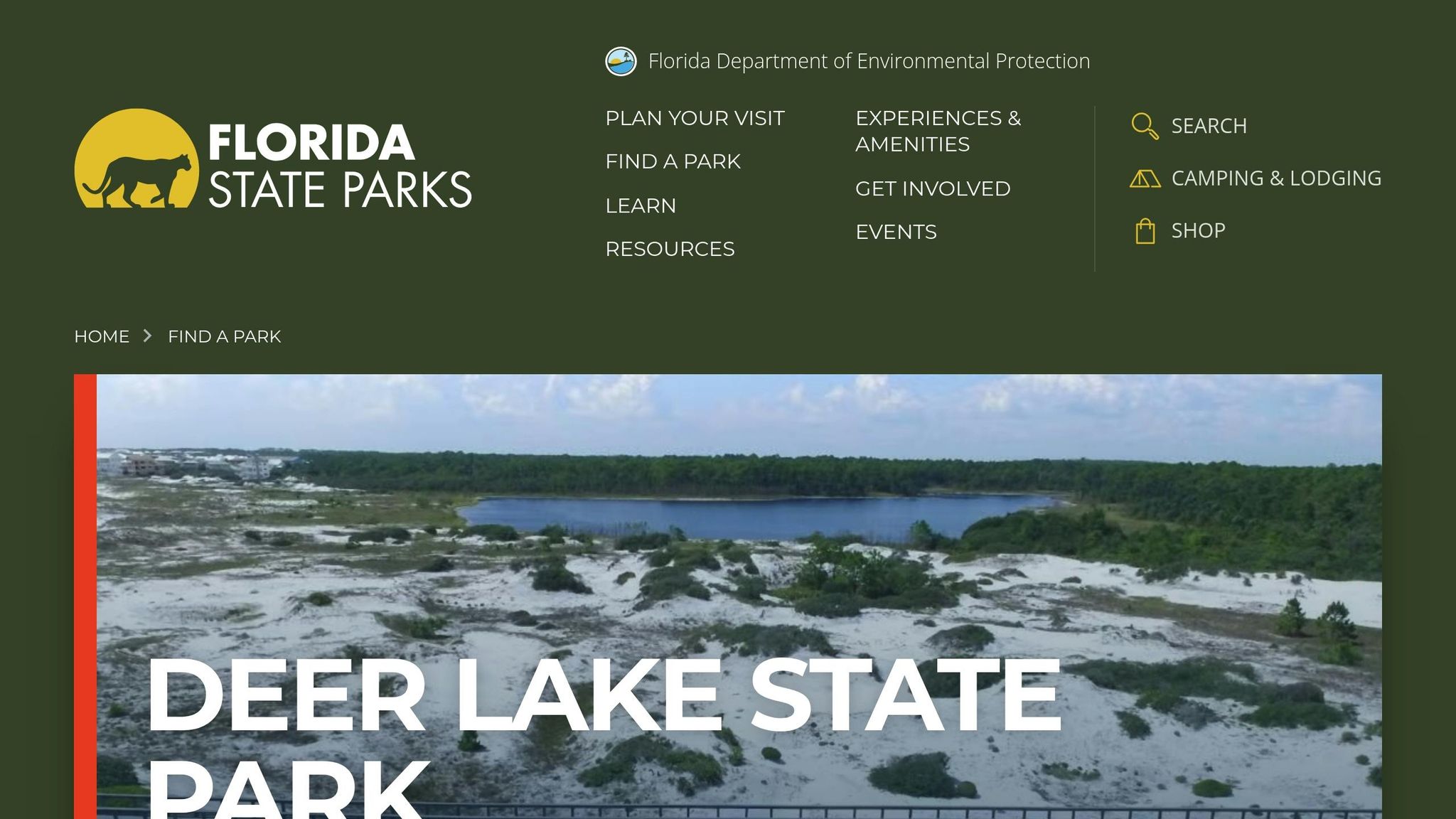
Deer Lake State Park boasts an impressive variety of birdwatching opportunities, thanks to its 11 distinct natural communities. The park's standout feature is its coastal dune lake, a rare ecosystem exclusive to the Gulf Coast. Along its pristine shores, you might spot species like the Piping Plover, Snowy Plover, Little Blue Heron, Reddish Egret, White Ibis, and Black Skimmers. A boardwalk system allows for unobtrusive observation of these sensitive birds. Beyond the beach, the park's wetlands - featuring basin swamps, dome swamps, and depression marshes - are home to unique plant species like pitcher plants, which, in turn, attract specialized bird species. The pine flatwoods and sandhill areas also provide critical habitats for upland birds.
Point Washington State Forest
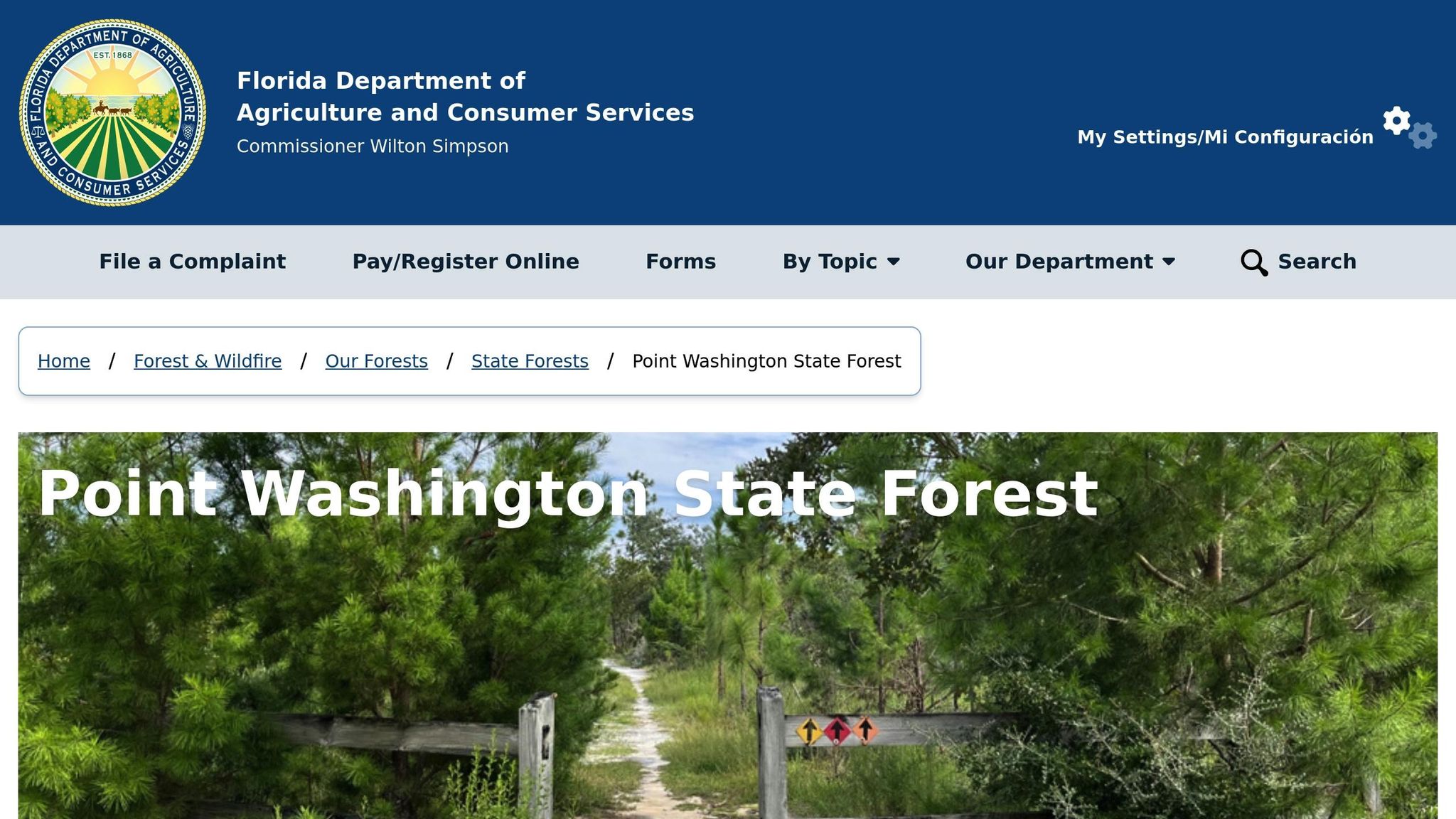
Point Washington State Forest is a vast expanse of diverse habitats, making it a prime spot for forest-dwelling birds. Its pine flatwoods, oak scrub, and longleaf pine ecosystems support species such as the Red-headed Woodpecker. Hardwood hammocks and seepage slopes offer food and shelter for migratory birds, while wet prairies and other microhabitats attract specialized species, particularly during dry spells. For those willing to venture into its more remote areas, the forest rewards visitors with exceptional bird sightings.
Inlet Beach and Quiet Shorelines
The quieter beaches of South Walton, especially around Inlet Beach, are perfect for spotting rare shorebirds like the Semipalmated Plover. These less-developed stretches provide the undisturbed environment that shorebirds need. Tidal zones and washover areas serve as feeding grounds for plovers, sandpipers, and other small shorebirds, particularly during tide changes. Behind the beaches, native vegetation offers nesting and shelter for birds that thrive in both beach and upland settings.
Rare Birds You Can Find in South Walton
South Walton's unique landscapes are home to a variety of rare bird species, offering birdwatchers a chance to encounter some truly captivating sights. Two species, in particular, stand out for their striking appearances and fascinating behaviors, making South Walton a birdwatching haven.
Semipalmated Plover
The Semipalmated Plover is a charming shorebird that thrives along South Walton's peaceful beaches. Walt Spence, a member of the Choctawhatchee Audubon Society, describes the bird's natural fit in the area:
"This shorebird species seems to fit right in on our beaches, with its sandy white chest and seashell-brown feathers. Head to the quiet shores of a beach neighborhood like Inlet Beach to watch the Semipalmated Plover scurry through sand and pick out tiny crustaceans and insects to eat; listen for its quick high-pitched whistle."
These small birds are drawn to sandy shorelines teeming with tiny crustaceans and insects, making secluded beach spots perfect for spotting their quick movements and hearing their distinct calls. While these delicate shorebirds enchant beachgoers, South Walton's skies are ruled by a more commanding presence.
Osprey
Ospreys are another must-see in South Walton, often spotted soaring over coastal waters, the ocean, and near the Eastern Lake outfall. Known for their dramatic hunting techniques, Ospreys are a favorite among bird enthusiasts. Walt Spence shares his admiration for these skilled hunters:
"The most entertainment I get from any bird here is from the Ospreys. They're fascinating to watch hunt. They circle overhead until they find something; and then they dive. They dive straight down and directly into the water - unlike other similar species. Sometimes they catch a fish that's so big, they can't even get airborne with it in their mouth. They have to drag it to shore."
For those hoping to catch a glimpse of these impressive raptors in action, Thomas Pilcher Park is an excellent spot, offering great views of water birds along the Choctawhatchee Bay.
How to Spot Rare Birds Successfully
Spotting rare birds in South Walton isn’t just about luck - it’s about timing, preparation, and using the right techniques. Whether you’re hoping to witness an Osprey’s dramatic dive or hear the distinct call of a Semipalmated Plover, these tips can help you make the most of your birdwatching adventure.
Best Times and Patience Tips
Birds are most active during the cooler parts of the day, typically between 6:00–9:00 AM and the two hours before sunset. These are prime times to catch them foraging for food or establishing territories. Make sure to spend at least 30 minutes at each spot to give yourself enough time to observe them without interruptions. The soft light during these hours also makes it easier to notice movement and identify subtle markings.
Patience is your best ally when birdwatching. Rare birds are often cautious and may take a while to reappear after being disturbed. Find a comfortable spot with good visibility and wait quietly for them to resume their natural behavior.
Keep an eye on the weather, too. Overcast skies can make birds more comfortable moving in open areas, while light rain may attract ground-feeding species as insects become more active. Being well-prepared with the right gear can also make a big difference.
Birdwatching Equipment You Need
Having the right tools can elevate your birdwatching experience. Here’s what you’ll want to bring:
- Binoculars: Look for models with 8x42 or 10x42 magnification. These provide a good balance of power and field of view, especially helpful in low-light coastal environments.
- Field guide for Florida birds: A guide with range maps is invaluable for identifying species native to the panhandle region.
- Waterproof notebook: Use it to jot down sightings, locations, and observations.
- Bird identification apps: Apps like eBird or Merlin Bird ID can help you log sightings, access real-time data from other birders, and even identify birds by photos or sounds.
Don’t forget essentials like a wide-brimmed hat, insect repellent, and a lightweight chair for comfort. Wearing neutral-colored clothing in shades of brown, green, or gray can help you blend into the environment.
How to Identify Birds by Sound
Once you’ve settled into your spot, your ears become just as important as your eyes. Learning to identify birds by their calls and songs is especially useful in areas with dense vegetation where visibility may be limited. Many species announce their presence through distinctive vocalizations, which can lead you right to them.
Start by learning the common calls in South Walton. For example, the Red-headed Woodpecker and Prothonotary Warbler have unique calls that make them easier to locate.
Practice focused listening by sitting quietly for 10–15 minutes and tuning into the different calls around you. Over time, you’ll get better at picking out individual sounds from the general background noise. If you hear an unfamiliar call, use your smartphone to record it. Later, compare the recording with birding apps or online databases to identify the species.
Keep in mind that vocal activity varies by time of day. The early morning, or “dawn chorus,” begins about 30 minutes before sunrise and lasts a couple of hours. There’s also a shorter burst of activity in the late afternoon.
Moving Quietly and Respecting Wildlife
Once you’ve spotted or heard a bird, staying low-key is crucial. Move slowly and deliberately to avoid startling them. Sudden gestures, like quickly pointing or jerking up your binoculars, can scare birds away. Instead, lift your binoculars gradually while staying as still as possible.
Stick to designated trails in places like Topsail Hill Preserve State Park or Deer Lake State Park. These trails are designed to minimize disruption to habitats while offering excellent viewing opportunities. Straying off the paths can disturb nesting sites or feeding areas, so it’s best to stay on track.
Always maintain a respectful distance. For smaller songbirds, staying 20–30 feet away is usually enough to avoid causing stress. Larger species, like Ospreys, need even more space. During nesting seasons, be extra cautious - if you hear distress calls or notice defensive behavior, back away slowly. Observing from a safe distance helps ensure these birds can thrive for future generations to enjoy.
sbb-itb-d06eda6
When to Go Birdwatching in South Walton
Planning your birdwatching trips in South Walton at the right time can make all the difference. Thanks to its location along major flyways, this area offers incredible opportunities to see both migratory and resident birds throughout the year. Here's a breakdown of the best times to spot them.
Spring and Fall Migration Periods
Spring migration, which runs from mid-March to early May, is the perfect time to see warblers, vireos, and other neotropical species as they make their way north to breed.
Fall migration, on the other hand, is when the bird diversity truly shines. From early September through October, South Walton becomes a hotspot for birdwatchers. Unlike the faster-paced spring migration, fall migration tends to stretch out as birds take their time heading south, often pausing to build up energy reserves for long flights. For instance, on September 28, 2025, over 30 million migrating birds crossed Florida, with more than 7.2 million flying over Walton County alone. Cold fronts during this period can cause birds to temporarily stop, creating spectacular viewing opportunities. After these weather events, head to local parks or natural areas at dawn to catch large, concentrated flocks.
Year-Round Resident Birds
If you’re not chasing migration patterns, South Walton still delivers. Resident species like the Osprey and Limpkin can be spotted any time of the year, ensuring there’s always something to see no matter when you visit.
Birdwatching Resources in South Walton
Having the right resources can make all the difference in your birdwatching experience. South Walton is home to a variety of tools and organizations that can help you identify species, find the best spots, and connect with other bird enthusiasts.
Choctawhatchee Audubon Society
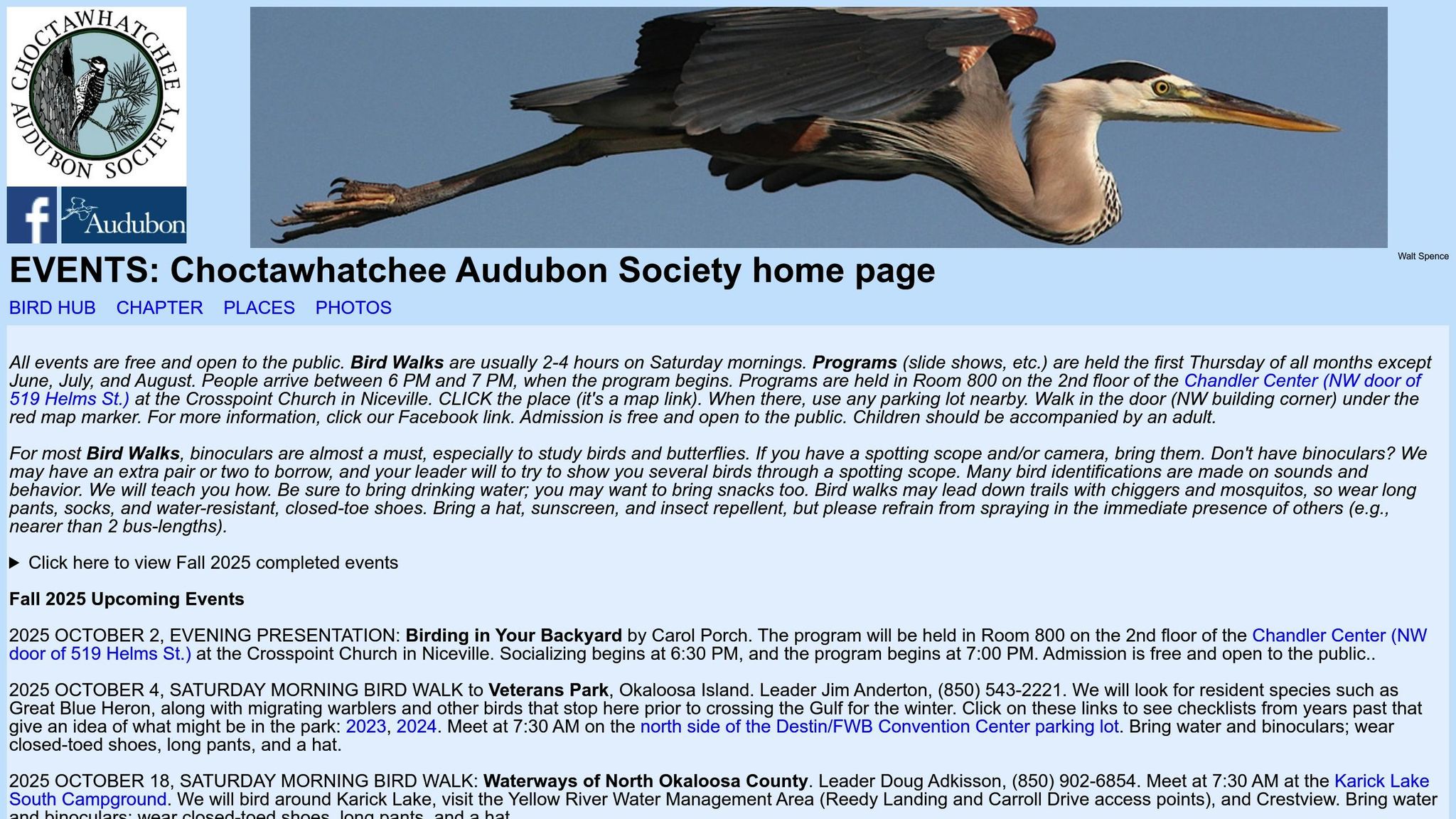
The Choctawhatchee Audubon Society is a key hub for birding in the area. They maintain detailed bird lists for South Walton and provide rare bird alerts, perfect for those looking to track down elusive species.
One of the highlights of this organization is its guided birding events. These outings let you learn from local experts who know where to find specific birds and can offer hands-on tips for identifying them in the field - something you just can’t get from a book. The society also organizes seasonal bird counts and takes part in citizen science projects that support bird conservation.
As a member, you’ll get regular updates on unusual sightings, which is especially handy during migration seasons when rare birds might pass through. Their deep understanding of local factors, like weather, tides, and seasonal shifts, provides a unique perspective on bird behavior specific to South Walton.
For additional help while in the area, check out sowal.co for practical tips.
sowal.co: Your South Walton Guide
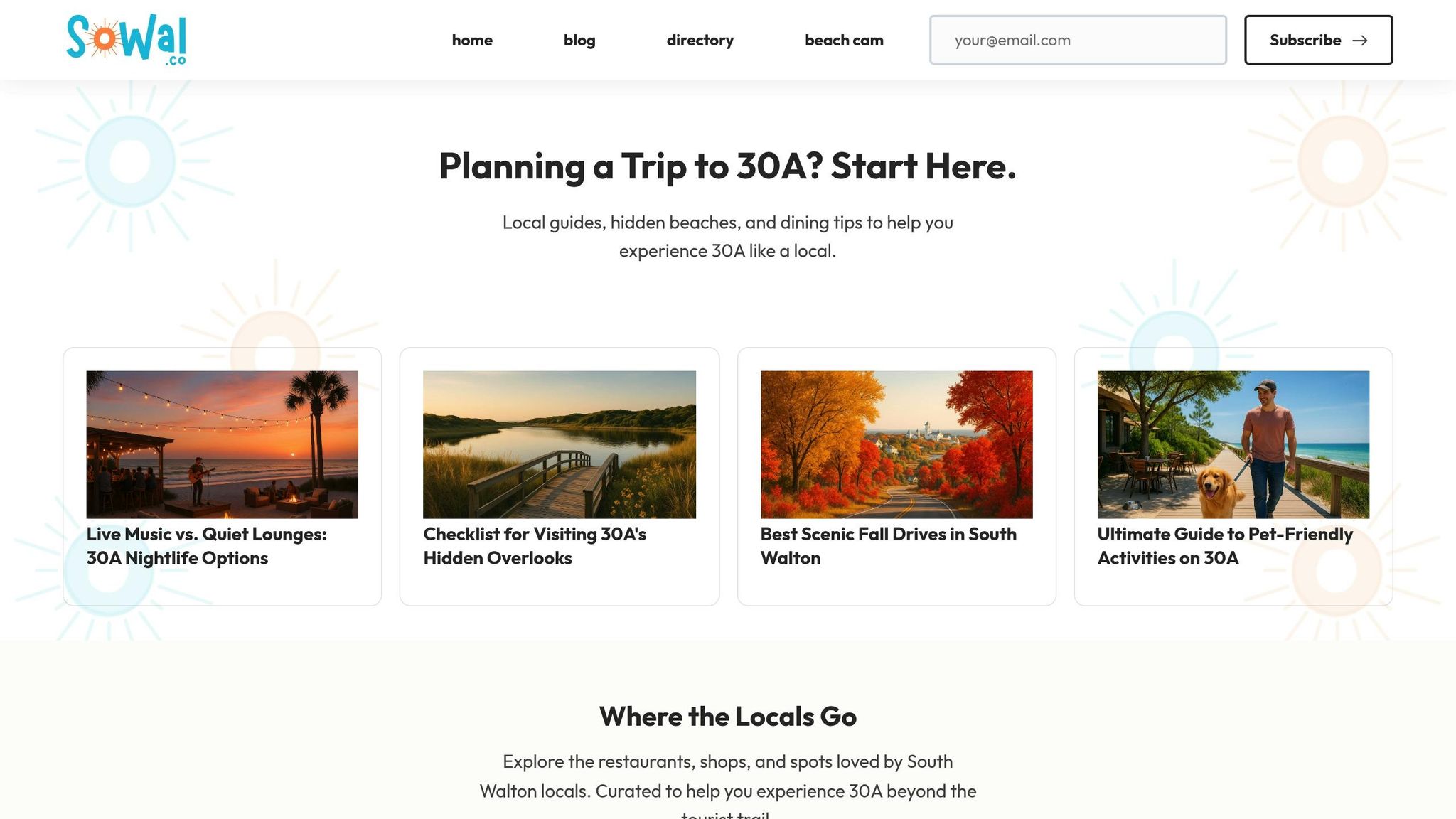
sowal.co is a digital resource designed with South Walton visitors and residents in mind. It’s packed with travel tips that highlight hidden birding spots - perfect for those seeking quieter, more personal wildlife experiences away from the usual tourist areas.
The site also keeps you updated on local events, such as peak migration times or special conservation programs, so you can plan your birdwatching trips when and where they’ll be most fruitful. Plus, sowal.co provides real-time updates on parking, trail conditions, and seasonal access, ensuring you’re fully prepared to make the most of your time in the field.
Getting Started with Birdwatching in South Walton
Thinking about diving into birdwatching? South Walton is a fantastic place to start, offering easy-to-access locations and a variety of bird species that make spotting rare finds both exciting and achievable.
To begin, you’ll need just a few essentials: a decent pair of binoculars (8x42 is a great all-around choice), a field guide specific to southeastern birds, and comfortable, sturdy shoes. No need to splurge right away - start with affordable gear and upgrade as you go.
Timing, however, is key. Birds are most active and vocal in the early morning, so plan to head out around sunrise for the best chances of spotting them. A great starting point is Topsail Hill Preserve State Park, which features well-maintained trails and open spaces perfect for beginners. Spend some time here to familiarize yourself with the local birdlife before diving into more advanced techniques like identifying calls or refining your approach to ethical birdwatching.
Speaking of which, moving slowly and listening carefully is crucial. Many beginners focus solely on spotting birds visually and miss the important cues provided by bird calls. Pause at promising locations - like near water, forest edges, or flowering plants - and let the birds come to you naturally. Patience often pays off with rewarding sightings.
From day one, make ethical birdwatching a priority. Stick to marked trails, keep noise to a minimum, and avoid using bird call recordings, especially during nesting season. If you’re lucky enough to spot a rare bird, observe it from a respectful distance and avoid lingering too long in its habitat.
Take advantage of local expertise by joining guided birding walks. These outings, often led by seasoned birders, provide valuable tips on identifying species unique to South Walton’s coastal and forest environments. They’re also a great way to discover hidden birding spots and learn faster than you would on your own.
To track your progress, keep a simple log of your sightings. Note the species, location, and time of each encounter. For example, jotting down a Red-headed Woodpecker seen during an early morning trip to Point Washington State Forest can help you spot patterns and plan future outings. Many birders find their most memorable discoveries come from revisiting familiar locations at the right time.
Start small and build gradually. Focus on one or two nearby spots instead of trying to cover every birding area in South Walton all at once. Get to know the common species first - it’ll make it easier to recognize the rarer ones when they appear.
FAQs
What are the best tips for beginner birdwatchers in South Walton?
If you're just starting out with birdwatching in South Walton, a great place to begin is at the coastal dune lakes or Inlet Beach. These spots are known for attracting a variety of birds, including the Semipalmated Plover and migratory songbirds. Spring and winter are prime times to visit, as many species are either nesting or passing through during migration.
To make your birdwatching adventure more rewarding, equip yourself with a quality pair of binoculars and a field guide specifically for Florida birds. Pay attention to the Five S's of birding - shape, shade, size, sound, and space - as these clues can make identifying different species much easier. For the best experience, explore green spaces, beaches, and nature trails during the quieter parts of the day, like early morning or late afternoon, when you're more likely to encounter rare and elusive birds.
What are the best tips for spotting rare birds during migration in South Walton?
If you're hoping to catch a glimpse of rare birds during migration in South Walton, the best time to visit is between late August and November, when fall migration hits its peak. Birds are most active during the early mornings and evenings, so plan your outings around these times for the best chances of spotting them. Seek out quiet, natural spots teeming with insects, such as Inlet Beach or the coastal dune lakes nearby, which often attract species like the Semipalmated Plover.
Don’t forget to bring a good pair of binoculars, and consider using bird identification apps to help you recognize calls and flight patterns. Staying updated on recent sightings through regional birding alerts or local birdwatching groups can also be incredibly helpful. With a bit of patience and preparation, your birding adventure could be one to remember!
What should I keep in mind to birdwatch responsibly in South Walton's natural areas?
When birdwatching in South Walton, showing care for the local wildlife and their habitats is key. Always avoid disturbing birds, especially during nesting season, and stick to designated trails and protected areas. Maintain a safe distance to prevent stressing the birds, and try to keep noise and sudden movements to a minimum.
Using playback calls or artificial sounds might seem tempting, but these can interfere with the birds' natural behaviors, so it's best to avoid them. Stay aware of your surroundings and leave no trace - pack out any trash and take care not to harm the vegetation. If you want to go a step further, supporting local conservation efforts can help ensure these stunning habitats remain intact for generations to come.

